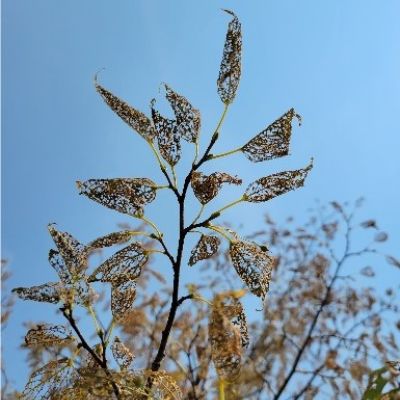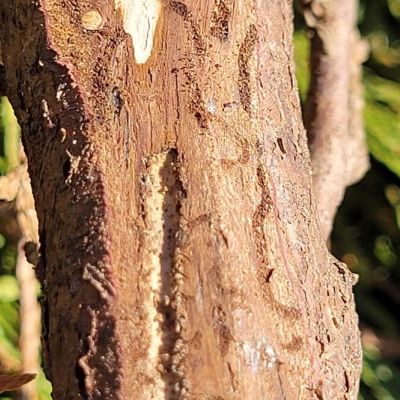Burkholder Plant Health Care 2022 Year In Review
2022 was the second full year in the field for Burkholder Plant Health Care. Having a year of local-property data and experience enabled us to measure our successes and adjust our program to address any shortcomings from 2021. As a certified arborist and the manager of Burkholder Plant Health Care, I am taking this opportunity to share with you our plant health care year in review, featuring the top plant health care issues– pests, diseases, and soil conditions — that we regularly addressed on clients’ properties this year.
Following is a list and descriptions of the most common plant health care issues that we saw, results of control efforts, and what we believe is in store for 2023.
6 Pennsylvania Plant Health Care Concerns in 2022
Deer Damage

Plant damage from deer is a threat to just about every property in this area. In fact, I would confidently say that on unprotected properties, deer inflict more damage (both feeding and antler-rubbing) than any other individual pest: insect, disease, or vertebrate. Damage from deer is exacerbated by the fact that deer target very common feature landscape trees and shrubs and flowering bedding plants. The most effective tool to control deer damage is likely a really good fence. Second is a free-ranging dog, and third is anything else you can throw at them, including deer repellents. Along with multi-component repellents to discourage deer feeding, we have solutions to minimize antler rubbing of trees and to control ticks that are along for the ride. Managing deer is no longer just a winter challenge, and we adjust our program by season and threat level to control deer behavior year-round, with the goal of making our clients’ properties undesirable for deer to visit.
Soil Health

Poor Growing Conditions and Soil Diseases
In nature, a rhododendron can live for 100 years or more; however, in residential landscapes, rhododendrons and azaleas can be exceptionally difficult to establish given environmental and pest pressures. In 2022, we found a lot of struggling mature plants whose decline could be traced to specific deficiencies in soil condition, planting site, or planting method.
Effect of Soil pH on Plants
Soil pH is an excellent example of a specific factor that has an inarguable effect on landscape plants, and for the vast majority of common and preferred landscape plants, the ideal pH range leans toward acidic (5.5-6.5). Many common landscape plants require acidic soil; however, of 192 properties on which we have formally analyzed soil chemistry in foundation beds, landscape beds, and beneath featured trees, 165 properties (86%) have a pH above 6.5, meaning that without amendment and adjustment, only 14% of local properties have the basic soil chemistry that supports health and vigor of preferred plants. In general, mature plants that are struggling are growing in compacted or otherwise unhealthy soil with little or no pore space for oxygen and water penetration or buffering of soil chemistry including pH.
Plants need healthy, biologically active, well drained, and well aerated soil to thrive. Fortunately, all of these biotic (soil biology) and abiotic (soil composition, planting techniques, and light/water availability) conditions can be corrected for struggling plants. Using specialized equipment, we can manage soil structure and chemistry, root physiology, and environmental stress to restore plant health, vigor, and aesthetic value.
Soil Diseases
A majority of landscapes in this area are supported by unhealthy soil. In addition to shortcomings in structure and chemistry, challenged soils are highly prone to harbor soil-borne plant diseases such as phytophthora root rot and black root rot, lethal diseases that colonize and kill the roots of many ornamental plants, starving the plants of water and nutrients. We have a very effective, integrated strategy to manage this disease, beginning with on-site testing and chemical analysis to confirm presence of the diseases, followed by multi-tactic chemical and physical treatment of soil and affected plants. Our team is trained to detect this disease before damage is irreversible, confirm diagnosis, and apply specific treatments to restore the function of the root system.
Bagworms and Beetles

Bagworm and Japanese Beetle
In late June each year, two insect pests emerge and can devastate certain groups of landscape plants: bagworm and Japanese beetle. Both of these pests can destroy the aesthetics of valuable landscape plants very quickly, and the greatest difficulty with both is the fact that when damage is apparent, it is too late to contain. In other words, management tactics must be in place before the peak population of the pest is actively feeding to ensure an acceptable level of damage control. Our team is trained to identify and treat for bagworm and Japanese beetle before damage is apparent, and our IPM program (Integrated Pest Management program) is structured to facilitate management of annual pests like bagworm and Japanese beetle before they become a problem.
Scale Insects

Scale insects continue to be the most prolific group of insects feeding on and damaging local landscape plants. Individuals of this diverse group of insects attach to various plant parts and feed on the vascular system of the plant, capturing and digesting nutrients as sap moves between the leaves and roots. Scale insects can build to astounding numbers on some plants. Of this group, the most important pests are currently
- White peach/prunicola scale
- Japanese maple scale
- Cottony camellia (taxus) scale
However, scale insects are affecting more plant species every year, and a majority of landscape plant species have one or more species of scale insects that feed on them and can cause significant damage. In fact, last year we were able to identify the first infestation of crape myrtle bark scale in the state of Pennsylvania and have since identified and treated this pest on dozens of properties. Our IPM program provides each of our clients’ properties with professional evaluations to determine throughout the year if plants are currently infested with or at risk of infestation with insidious scale insects, allowing treatment and control before the plants are damaged beyond repair.
Boxwood Leafminer

Leafminer is the most destructive insect pest of boxwood. These are fly larvae and they feed between layers of leaves, creating patchy discoloration on the tops of the leaves and light-colored blisters on the lower surface. Leaves are eventually killed by the feeding of the larvae and turn brown, destroying the aesthetics of the plants. Proactive treatment of boxwood leafminer is critical to bringing this pest under control and protecting boxwoods, which are often the most highly featured and valuable plant installations on residential properties. Management of boxwood leafminer requires accurate diagnosis and precise timing of treatment to coincide with vulnerable growth stages of the insect, without collateral damage to beneficial insects such as honeybees and other pollinators. This season, we worked on 97 properties with featured boxwoods (10+ plants), and boxwood leafminer was detected on 80% of these properties (78 of 97).
Arborvitae Borers

Arborvitae (especially Green Giant and Emerald Green) are among the most common landscape trees in this area. Historically, these have also been among the most durable and reliable landscape plants, fast-growing, consistent shape and size, and relatively insect and disease resistant. From our experience, there are only four common problems with arborvitae in general: deer browse, bagworm, phytophthora root rot, and wind/snow/ice damage. In 2021, we started to see damaged arborvitae in nurseries: trees with individual flagging limbs: dull green-gray branches that turn brown and shed their foliage. On trunks and limbs of these damaged trees, we found a particular species of bark beetle (shothole borer)—tiny beetles whose larvae tunnel just beneath the bark and can kill branches. When there are enough beetles in a tree, they can kill large sections, eventually leading to tree death. In 2022, we observed much more damage from this pest particularly in newly installed trees, and further examination revealed that it is most likely that trees were being infested and damaged immediately after planting. Trees stressed by transplanting conditions produce ethanol, and beetles in surrounding woods are attracted to the odor of these trees, quickly colonizing and damaging branches in as little as 6 weeks after planting. Our program has adapted to manage this risk, preventatively treating transplanted arborvitae after installation, monitoring for early indications of infestation, and nurturing new trees to full health and vigor to reduce likelihood of damage using the trees’ own defensive mechanisms.
Contact Burkholder PHC for Exceptional Treatment of Plant Care Issues
Burkholder PHC has a team of experienced, qualified arborists who will visit your property, conduct a plant health care evaluation, diagnose the problems, and inform you of the recommended treatment options. In addition, we provide a proactive approach, helping encourage and maintain your trees’ health and appearance.
If you are a current or past client of Burkholder Plant Health Care, thank you for trusting us with the care of the structure and biology of your landscape plants. If you have not brought our services onto your property and are interested in an assessment of the condition of your landscape plants, just let me know (starker@burkholderphc.com). All of our initial evaluations, sampling, and diagnostics are free for current or past clients of Burkholder Brothers. For more information about the Burkholder Plant Health Care Year in Review, give us a call.







